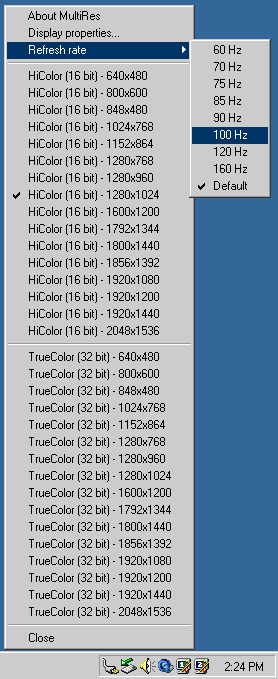|
 MultiRes
works very much like a 32-bit version of the venerable
Microsoft QuickRes 16-bit applet for Windows 95, with
administrative scripting facilities and extended capabilities
to handle ClearType, refresh rates and multiple monitors. Supported
resolution and refresh rates are accessible from the command-line
or from a simple menu that pops up from the system tray.
An optional timed confirmation prompt – enabled
by default in the program About box – ensures that
any changes you make can be reversed safely, without fuss.
While MultiRes - unlike EnTech’s PowerStrip
- does not allow you to define new display settings, it
does give you quick and easy access to the ones the driver
makes available – in a simple, compact and conservative
package. MultiRes
works very much like a 32-bit version of the venerable
Microsoft QuickRes 16-bit applet for Windows 95, with
administrative scripting facilities and extended capabilities
to handle ClearType, refresh rates and multiple monitors. Supported
resolution and refresh rates are accessible from the command-line
or from a simple menu that pops up from the system tray.
An optional timed confirmation prompt – enabled
by default in the program About box – ensures that
any changes you make can be reversed safely, without fuss.
While MultiRes - unlike EnTech’s PowerStrip
- does not allow you to define new display settings, it
does give you quick and easy access to the ones the driver
makes available – in a simple, compact and conservative
package.
Scripting examples
• Applying display settings to multiple monitors:
multires.exe /1:800,600,32,75 /2:1024,768,16,60 /3:640,480,8,85
where the first set of display settings (800,600,32,75)
is applied to monitor number 1, the second set (1024,768,16,60)
is applied to monitor number 2, and the third set of display
settings (640,480,8,85) is applied to monitor number 3.
• Changing the ClearType settings under Windows XP:
multires.exe /ClearType=1600
where the 1600 instructs MultiRes to enable ClearType font smoothing and set the contrast value to 1600
• Restoring previous display settings:
multires.exe /restore
MultiRes always stores current display settings prior
to making any changes, so that they can be easily restored
on demand. This faciliates batch file processing, where
it is desireable to run a specific application at a specific
color depth and/or resolution, and then restore normal
display settings when the application is closed. In the
example below, assume the system is normally run at 1024,768,16
but it is desireable to run Internet Explorer at 800,600,32.
: batch file
multires.exe /800,600,32
start /w iexplore.exe
multires.exe /restore
For more examples and explanations, please refer to the
documentation included with MultiRes.
|



